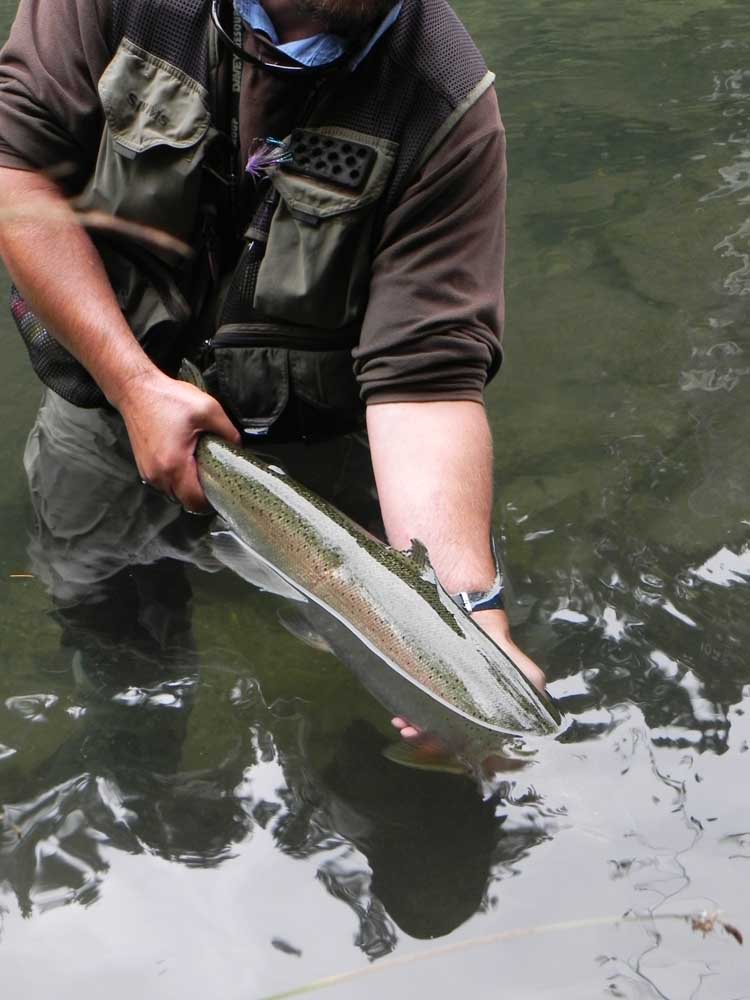Steelhead flies: the Skunk origin myth revisited
Published 12:00 am Monday, April 2, 2018

- Mark Stangeland prepares to release a fly-caught summer steelhead teased up by Geoff Hill on the North Umpqua.(Gary Lewis/For The Bulletin)
“Black on the bottom, white in the middle and black on top. Skunk hair,” Jim Dexter said.
The object of our conversation, a faithful-to-the-original version of the Skunk, a classic steelhead fly, sat on the table in front of me. It was tied with oval silver tinsel, although the tinsel was buried in the black chenille of the body. It bore a black skunk-hair wing, from which the pattern drew its name. And it was topped with polar bear.
Polar bear hair is hard to obtain these days, but its qualities have not been forgotten.
“It has a sheen in the water. There is nothing else like it,” Dexter said.
An avid fisherman and tier of flies, Dexter makes his home in La Pine. From his home base, it is not far to fish his favorite waters — the Deschutes River and Lava Lake.
Dexter took out another fly, this one an updated version of the Green Butt Skunk.
It sported a chartreuse tag with red hackle fibers, a shorter body and a wing tied of polar bear with pearl Krystal Flash.
In the book “Fish Flies: The Encyclopedia of the Fly Tier’s Art,” author Terry Hellekson gives the tying recipe for the original Skunk. Its tail is crimson red hackle barbs. The body is black chenille ribbed with oval silver tinsel. The hackle is black, tied on as a collar, laying back and down. The wing is black skunk hair with an overwing of white skunk hair. Hellekson discusses the origin of the fly, credited by some to Wes Drain, of Seattle, who tied a similar fly for the Stillaguamish River north of Seattle in the 1930s. Another claim, Hellekson reported, tied it to the North Umpqua in southwest Oregon.
Hellekson didn’t lend that one credence, but he was probably referring to the Mildred Krogel story. Mildred Krogel was a fly tier from Roseburg. And a lot of the early Skunks came from her desk.
“My father,” Hellekson wrote, “obtained a sample of the fly from Jim Pray in 1934. I have concluded that it is most likely not an Oregon fly.”
Dexter (his friends call him Dex) would agree with that statement. He told me the rest of the story.
“Dad had the Redwood café down in Fortuna (California). He was the chef,” Dex said. Before that, the elder Dexter owned the café at the bus depot in Eureka (California).
“His name was Rollin Benjamin Dexter, but his friends called him Rosie.”
Dexter figures his dad was born about 1908, which would have put him in his mid-30s when little Jim was born.
“He told me about tying the Skunk ever since I was in diapers. He tied it for the Eel River; for steelhead,” Dex said. “He had another fly he tied for silvers, it was called the Black and White Plastic.”
Dex held one up. “No one has ever seen this,” he said.
The Black and White Plastic was tied small, on a Mustad offset hook, long before the style of salmon and steelhead hooks in favor today. The Skunk, also, was tied smaller in those days.
“The Skunk always had a red tail. Just hackle fiber. It had a black chenille body. It had a silver oval tinsel rib — large. You can’t buy it today. I can’t find the big stuff. It had black hackle up front and skunk for a wing. Black on the bottom, white in the middle and black on top. That’s where it got its name.”
Among Rosie’s best friends was Jim Pray, the owner of a small fly shop in Eureka, 22 miles north of Fortuna.
Jim Pray sent a copy of Rosie’s Skunk off to Zane Grey and the steelhead fly tied with the hair of a common stink weasel began to gain admirers in the Northwest.
It has long been a favorite steelhead fly, although its offspring, the Green Butt Skunk, might be more effective.
An angler named Dan Callaghan added the green butt to the original Skunk in the early 1950s. Tied in many variations, both the Skunk and its kittens are topped with calf tail — sometimes black and white and most often in white. But to get it right, a person wants to tie with skunk hair. Add polar bear if you can find it.
If you get close enough to shave a skunk, save a little of that fine wing material for me.
Dex favors the chartreuse tag on the rear of the Skunk, but when he talked about it, he shivered.
“If dad saw me putting a green butt on that thing, he’d kick my ass.”
— Gary Lewis is the host of “Frontier Unlimited TV” and author of “Fishing Central Oregon,” “Fishing Mount Hood Country,” “Hunting Oregon” and other titles. Contact Lewis at www.GaryLewisOutdoors.com.








